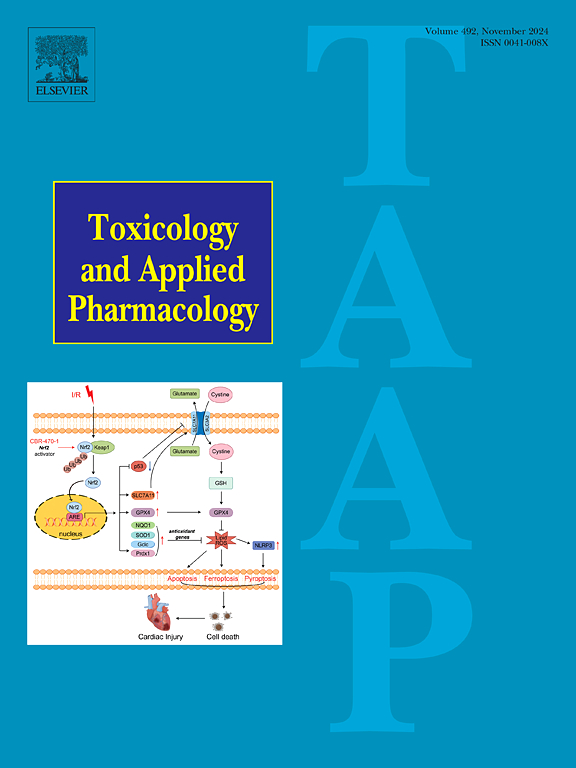波纳替尼对卡吡嗪体内外代谢的影响及其机制
IF 3.4
3区 医学
Q2 PHARMACOLOGY & PHARMACY
引用次数: 0
摘要
卡吡嗪是一种抗精神病药物,已被批准用于治疗精神分裂症和躁狂或混合性发作。肿瘤患者常出现精神障碍,需要联合使用抗肿瘤和抗精神病药物。本研究的目的是考察三种抗肿瘤药物(奥尔穆替尼、纳布卡辛和波纳替尼)对卡雷帕嗪代谢的抑制作用,并评估卡雷帕嗪和波纳替尼对CYP3A4的分子对接关系。结果表明,波纳替尼和奥尔穆替尼的体外半最大抑制浓度(IC50)值分别为<;10 μM, napabucasin为20 μM。其中,波纳替尼的IC50值最小。观察了大鼠肝微粒体(RLM)存在或不存在波纳替尼时卡吡嗪的代谢稳定性。IC50移位实验表明,波纳替尼对卡吡嗪的抑制作用是非时间依赖性的。此外,波纳替尼分别以混合方式(RLM)和竞争方式(HLM)抑制卡吡嗪。在体内研究中,波纳替尼联合给药导致卡吡嗪的AUC(0-t)和AUC(0-∞)均显著增加0.35倍,CLz/F显著降低0.25倍。此外,代谢物去甲基-卡里帕嗪(DCAR)和二甲基-卡里帕嗪(DDCAR)的AUC(0-t)和AUC(0-∞)均有不同程度的增加。分子对接研究表明,卡吡嗪和波纳替尼都能与CYP3A4上的残基ph -304发生疏水相互作用。因此,在临床应用波纳替尼与卡吡嗪合用时,必须评估其疗效和不良反应,并调整剂量以达到最佳疗效。本文章由计算机程序翻译,如有差异,请以英文原文为准。
Effect of ponatinib on the metabolism of cariprazine in vitro and in vivo and the underlying mechanism
Cariprazine is an antipsychotic medication that has been approved for the treatment of schizophrenia and manic or mixed episodes. Patients with tumors frequently develop psychiatric disorders, necessitating the combination of antitumor and antipsychotic drugs. The objective of the present study was to examine the inhibitory impacts of three antitumor drugs (olmutinib, napabucasin and ponatinib) on the metabolism of cariprazine, and the molecular docking of cariprazine and ponatinib in relation to CYP3A4 was also evaluated. As the results, the half-maximal inhibitory concentration (IC50) values of ponatinib and olmutinib in vitro were < 10 μM, whereas napabucasin was >20 μM. Among these, ponatinib exhibited the smallest IC50 value. The metabolic stability of cariprazine was observed in the presence or absence of ponatinib in rat liver microsomes (RLM). The IC50 shift experiments demonstrated that the inhibition of cariprazine by ponatinib was non-time-dependent. In addition, ponatinib was shown to inhibit cariprazine in a mixed manner (RLM) and a competitive manner (HLM), respectively. In the in vivo study, the co-administration of ponatinib resulted in a significant 0.35-fold increase in both AUC(0-t) and AUC(0-∞) for cariprazine, accompanied by a significant 0.25-fold decrease in the CLz/F. Furthermore, the metabolites desmethyl-cariprazine (DCAR) and didesmethyl-cariprazine (DDCAR) exhibited disparate increases in both AUC(0-t) and AUC(0-∞). Molecular docking studies had demonstrated that both cariprazine and ponatinib could engage in hydrophobic interactions with residue PHE-304 on CYP3A4. Consequently, when ponatinib is employed in conjunction with cariprazine in a clinical setting, it is imperative to assess the efficacy and adverse effects, and adjust the dosage to attain the optimal efficacy.
求助全文
通过发布文献求助,成功后即可免费获取论文全文。
去求助
来源期刊
CiteScore
6.80
自引率
2.60%
发文量
309
审稿时长
32 days
期刊介绍:
Toxicology and Applied Pharmacology publishes original scientific research of relevance to animals or humans pertaining to the action of chemicals, drugs, or chemically-defined natural products.
Regular articles address mechanistic approaches to physiological, pharmacologic, biochemical, cellular, or molecular understanding of toxicologic/pathologic lesions and to methods used to describe these responses. Safety Science articles address outstanding state-of-the-art preclinical and human translational characterization of drug and chemical safety employing cutting-edge science. Highly significant Regulatory Safety Science articles will also be considered in this category. Papers concerned with alternatives to the use of experimental animals are encouraged.
Short articles report on high impact studies of broad interest to readers of TAAP that would benefit from rapid publication. These articles should contain no more than a combined total of four figures and tables. Authors should include in their cover letter the justification for consideration of their manuscript as a short article.

 求助内容:
求助内容: 应助结果提醒方式:
应助结果提醒方式:


